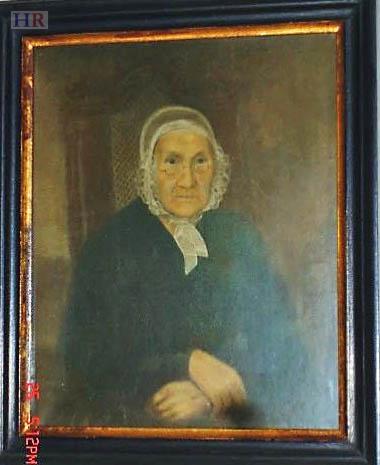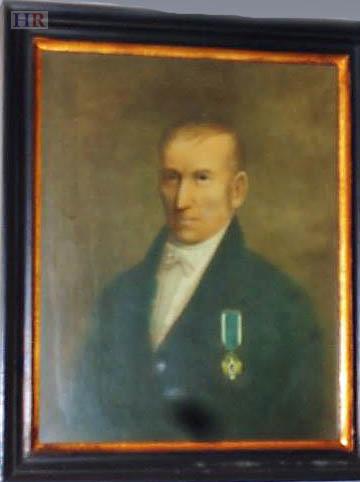Mercy and Abijah Richardson

Alice’s great-grandmother Mercy Daniels Richardson, (whose ancestors Joseph Daniell and Mary Fairbanks were neighbors of Benjamin Bullard’s family at the Farms) was born in 1755 during the French and Indian War, the same year the Acadians were expelled from Nova Scotia by the British and she was alive well into the following century. The oldest of Mercy’s seven surviving children, was Betsey Richardson. Betsy’s youngest child was Alice’s mother, Bethia Wheeler. Great-grandmother and the Revolutionary War was not just a story told to Alice by her mother; Mercy Richardson and her great-granddaughter Alice Bullard’s lives overlapped. When Alice was born, Mercy was 89 years old and she lived another ten years. Alice knew her great-grandmother and probably heard from her first-hand stories of the Revolutionary War.

Mercy’s husband, Alice's great-grandfather Abijah Richardson, was born on August 8, 1752. When he married seventeen year old Mercy Daniels on November 24, 1772 he was twenty. Not uncommon for the time, she was three months pregnant. He served four years as a surgeon during the Revolutionary War, part of that time at Valley Forge. Before that, while studying medicine at Harvard College, he had been called on to assist a sick soldier in George Washington’s entourage which was just then in Boston. He was one of the founding officers in Washington’s Society of the Cincinnati created at the close of the War of Revolution.
Abijah Richardson retired from the Army in 1781 at age twenty-nine to practice medicine in East Medway (now Millis); his house was just a half-mile from where Benjamin Bullard first settled. He was a knowledgeable botanist and herbalist who compounded many of the medicines he used from local plants he collected in the field. Abijah was respected and well-liked in the town. He became a Swedenborgian in religion in spite of its leader’s mistaken end of the world prophecy, joined the Masons, and served on the school committee. He was also “prominent in starting the manufacturing interests” in East Medway. [Jameson, E.O., History of Medway Mass., 1886.] He was described as “a man of fine personal address, commanding figure, and with his military and medical reputation he at once became a prominent personage in the town.”
Swedenborgianism is the belief system developed from the writings of the Swedish theologian Emanuel Swedenborg (1688 – 1772). It is claimed by its followers to be a new form of Christianity. In the U.S., Swedenborgianism was organized in 1817 with the founding of the General Convention of the New Church (sometimes referred to as the Convention), now also known as the Swedenborgian Church of North America. According to James Randi, mystic and theologian Emmanuel Swedenborg, decided after consulting with the angels that the world would end in 1757. It didn’t. The general view of New England religious tradition has been the Trinitarianism of the Congregational Church which was strong in most communities. There were other divergent views and traditions as well of which two were most divirgent from the traditional Congregational; Swedenborgians held there was One Divine God and that Jesus became One with God and the Unitarians who believed in One God with Jesus as a prophet and a man but not Divine.
The Masons were and are an esoteric fraternal society - the Masons’ principal involvement remains charitable work within a local or wider community, moral uprightness (in most cases requiring a belief in a Supreme Being) as well as the development and maintenance of fraternal friendship and business networks.
Abner Morse described how in 1770, Abijah “entered Harvard College, where he remained two years. He then commenced the study of Medicine. Having completed his studies, he entered the Revolutionary Army in the capacity of surgeon's mate, under Dr. Samuel Whitwell. [Dr. Whitwell spent the winter of 1777-78 at Valley Forge with George Washington, which would seem to indicate that Abijah was there as well.] He afterwards received a surgeon's commission, and continued in the service of his country until the close, or near the close of the war. He then settled as a physician, in Medway, and there continued in the active and successful performance of the duties of his profession until his death, May 10, 1822, age 70. Few physicians pass their professional career more honored or beloved.
"He was an eminent Botanist; indefatigable in the pursuit of knowledge, and with a memory so retentive that he seldom forgot what he had once acquired. He performed the duties of every relation of life with the most scrupulous exactness. He was affable, communicative, benevolent; but not obtrusive. He was an honor to his profession and to his country; and for many years to come his memory will be held in grateful recollection in the vicinity in which he lived. He married Mercy Daniels, who lived until 1854, receiving from her grateful and prosperous country a handsome annual pension, as a token of gratitude for services rendered by her husband in the day which tried men's souls.”
Abijah was one of the 69 petitioners from Medway “asking that a turnpike road might be laid out and established”…to connect with the Dedham and Boston Turnpike. The company to be called The Hartford and Dedham Turnpike Corporation.” E.O. Jameson says in his History of Medway that, “The Hartford and Dedham Turnpike Corporation came into existence by an act of incorporation passed March 9, 1804. Among the corporators were Abijah Richardson, M. D., Joseph Lovell, Willard Boyd, Elias Richardson, Jr., Benijah[sic] Pond, Abner Morse, and Artemas Woodward. An engineer's plan of the road, dated 1807, is filed with the papers in the office of the Secretary of State. “The Hartford and Dedham Turnpike" was constructed and opened to public travel in 1807. A toll-gate was placed near the “Hammond Place," afterward the railroad crossing in East Medway, and tolls were collected for many years. The stock in this road sold in 1808 for fifty dollars per share, but in ten years it had declined to about ten dollars.
As is commonly the case with roads in Massachusetts, Jameson added; “The turnpike at length came to need expensive repairs, and the corporation decided to relinquish the care of it to the town, and accordingly, the County Commissioners were petitioned to lay it out as a public highway. After two or three years spent in negotiations, the town paid one hundred and sixty dollars into the county treasury, and the Commissioners, June 4, 1838, established the turnpike as a public highway. The road was at once repaired, and that portion of it lying through Black Swamp was placed under the care of William La Croix, Esq.*, as agent for the town, the other portions were assigned to the several highway districts. It is the longest highway in the town, and is called Main Street.
*see later
In 1792 Abijah was appointed Justice of the Peace; in 1794 at the age of forty-two Abijah was elected a town selectman in Medway and remained in office until 1797. He was again elected as a selectman in 1801. He was on the School Committee almost every year from 1805 through 1813 and again from 1818 to 1820.
Alice’s great-grandmother Mercy, on the other hand, was allegedly known by the neighbors as a “devil”. According to her grandson, Charles L. Richardson,* Granny Doctor had a very strong personality; including a very strong will…it is certain that she left a reputation of having been a forceful character. When her husband went off to the war, she ran the Farm herself…she went barefoot, smoked a clay pipe, and kept a barrel of rum in the cellar. She had nine children* of whom two were born before and seven after [Abijah] went off to the war. Mercy Richardson not only did a woman's work in the world, but could substitute for a man when occasion required. She had a strong body as well as a strong brain, and made use of them both... She could digest any kind of food, half-cooked or greasy as well as any other kind … She worked hard and finally wearing herself out, she died at the age of 99.
*According to Jameson, Mercy had ten children; of whom seven survived. Jameson, E.O.; The History of Medway Mass. 1713-1885
Often, the wives of medical men in this period treated patients in the absence of their husbands. Or, while the husband took care of illness and injury, the wife was in charge of birthing babies and caring for their mothers. There is no reason to believe that a strong-willed woman like Mercy didn’t see patients and birth babies. She died in 1854 when her great-granddaughter Alice, was ten years old. Her wedding ring, now at the farm, is engraved with the words, "No riches like contentment."
*Kingsbury, John; Recollections and Reminiscences, 2000.
As I grew up in the twentieth century, this old nursery rhyme had little meaning for me but it clearly describes the rhythm of daily chores for my great-grandmothers a hundred years earlier.
This is the way we wash our clothes
so early Monday morning.
This is the way we iron our clothes
so early Tuesday morning.
This is the way we mend our clothes
so early Wednesday morning.
This is the way we sweep the floor
so early Thursday morning.
This is the way we scrub the floor
so early Friday morning.
This is the way we bake our bread
so early Saturday morning.
This is the way we go to church
so early Sunday morning.
.jpg)
Life was different in the nineteenth century. Perhaps it was a quieter life, but certainly it was busier with the business of survival. The work was endless and sometimes — in winter — the isolation of the Farm, three miles from any town, was nearly unbearable for some of its inhabitants. In the nineteenth century, a farmer’s life in general, was a continuous skirmish against the weather; success depended directly on the season and the climate. Existence was closer to the soil and of necessity therefore, for women, closer to the broom and the clothesline. The daily chores for which Alice and her family were responsible in order to maintain the family farm as a profitable enterprise were back-breaking and time consuming. It was not until the mid-twentieth century, when electricity and tractors became widely available that farm work became slightly less exhausting.
Great story! My husband is an ancestor of Abijah and Mercy. Where are these portraits housed? Is the house open to visitors?
Rachel Kidder | 2016-08-20 16:09:50